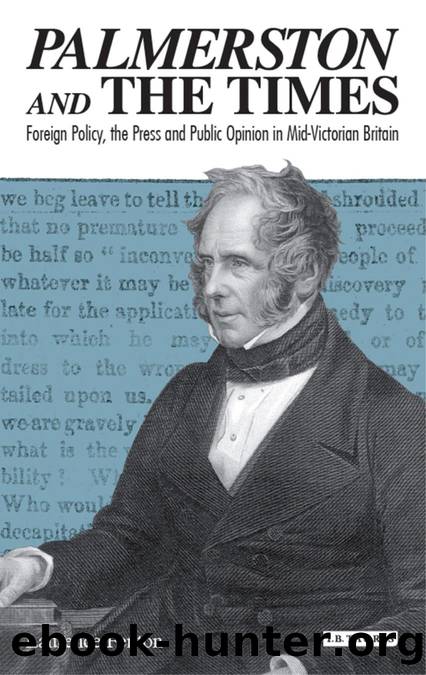Palmerston and the Times: Foreign Policy, the Press and Public Opinion in Mid-Victorian Britain by Laurence Fenton

Author:Laurence Fenton [Fenton, Laurence]
Language: eng
Format: epub
Tags: History & Theory, Great Britain, Europe, Political Science, History, General
ISBN: 9780857723550
Google: N93kDwAAQBAJ
Goodreads: 52751079
Publisher: Bloomsbury Academic
Published: 2012-11-06T11:57:02+00:00
King Bomba
The infectious thrill of the spring of 1848 gave way in the summer to fears among ordinary citizens that radicals were attempting to push the revolutions too far to the left. Conservative forces began to regain the initiative, most clearly on the battlefields of northern Italy where Austrian troops under the command of Radetzky smashed their way through the Piedmontese line at Custozza in late July. An armistice was signed within weeks and Charles Albert withdrew his forces from Lombardy. Vienna, too, was restored to order, as was Prague amidst fears of a âcommunist uprisingâ.44 General Eugene Cavaignac, commander of the troops who put down the âJune daysâ rising, was installed as a quasi-dictator in France. Then in December the conservative figure of Louis Napoleon Bonaparte, nephew of the great Napoleon, was elected president of the Second Republic, his victory ascribed more to a peasant revolt against the whole political class than a sentimental vote for a famous name.45 Nevertheless, there remained a few places where the rebels continued to hold sway, among them Sicily.
Although less celebrated than France, Sicily was in fact the scene of the first revolution of 1848. It was part of the âKingdom of Two Siciliesâ â the island of Sicily and the southern part of the Italian peninsula â and ruled by King Ferdinand II in Naples. The rising of citizens in Palermo in January 1848 led to similar demonstrations on the Neapolitan mainland. Ferdinand appeased his subjects in Naples by releasing political prisoners and granting a constitution. It was a short-lived taste of freedom, brought to an end by âcannon, musket-ball and bayonetâ at the beginning of summer. Sicily proved more resilient, a revolutionary government demanding autonomy and the restoration of their 1812 constitution. In April, the parliament at Palermo went even further, decreeing the deposition of the hated monarchy. Sicily, Mike Rapport writes, was for a few months âtruly an independent stateâ.46 It was not until the spring of 1849 that Ferdinand finally reasserted his authority, bombing the island into submission and earning in the process the moniker âKing Bombaâ.
There had been close relations between Britain and Sicily during the latter years of the Napoleonic Wars, and Palmerston was sympathetic to the desire for constitutional government. However, the Foreign Secretary would not countenance a complete separation of the two territories as it was too drastic an alteration to the territorial status quo. âI hope you will have been able to settle matters between the Sicilians & the Govt of Naples without a separation of the Crowns,â he wrote to a representative in Italy.47 Yet the impression to gain credence at the time was that Palmerston had âsupported by all means in his powerâ the Sicilian insurrection.48 This idea was reinforced when, on 6 January 1849, The Times revealed the Foreign Secretaryâs supposed involvement in the arming of Sicilian insurgents. The story centred on events in November 1848, when a Sicilian deputation had approached Tom Hood, an arms manufacturer in London, seeking supplies.
Download
This site does not store any files on its server. We only index and link to content provided by other sites. Please contact the content providers to delete copyright contents if any and email us, we'll remove relevant links or contents immediately.
Harry Potter and the Goblet Of Fire by J.K. Rowling(3046)
Unfinished: A Memoir by Priyanka Chopra Jonas(2918)
Never by Ken Follett(2881)
The Man Who Died Twice by Richard Osman(2300)
Machine Learning at Scale with H2O by Gregory Keys | David Whiting(2291)
Fairy Tale by Stephen King(2070)
Will by Will Smith(2042)
Rationality by Steven Pinker(1765)
The Storyteller by Dave Grohl(1660)
The Dawn of Everything: A New History of Humanity by David Graeber & David Wengrow(1571)
The Dark Hours by Michael Connelly(1570)
The Stranger in the Lifeboat by Mitch Albom(1532)
Cloud Cuckoo Land by Anthony Doerr(1435)
The Becoming by Nora Roberts(1331)
Friends, Lovers, and the Big Terrible Thing by Matthew Perry(1328)
New Morning Mercies: A Daily Gospel Devotional by Paul David Tripp(1325)
Crying in H Mart by Michelle Zauner(1316)
Einstein: His Life and Universe by Walter Isaacson(1315)
A Short History of War by Jeremy Black(1300)
